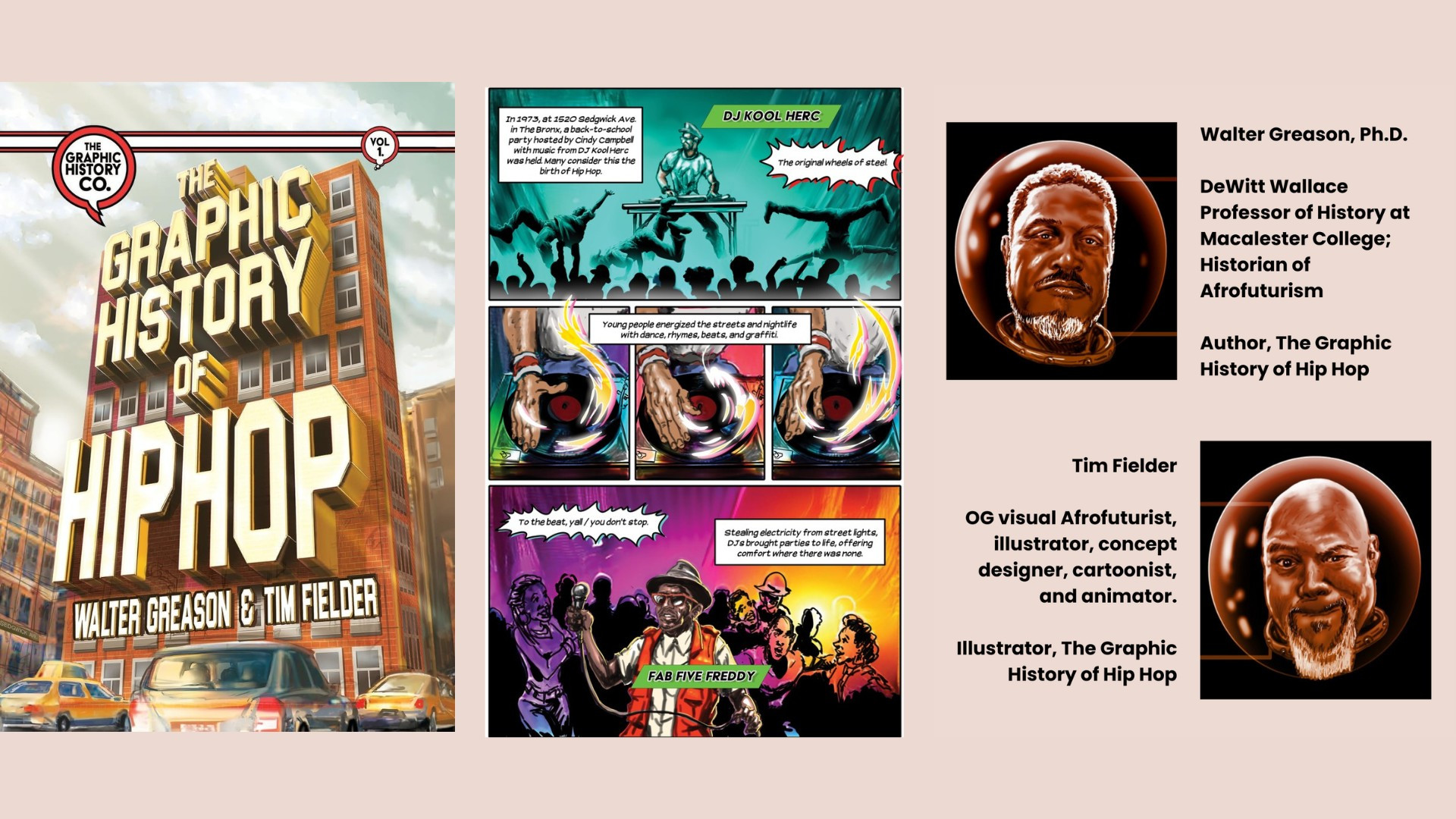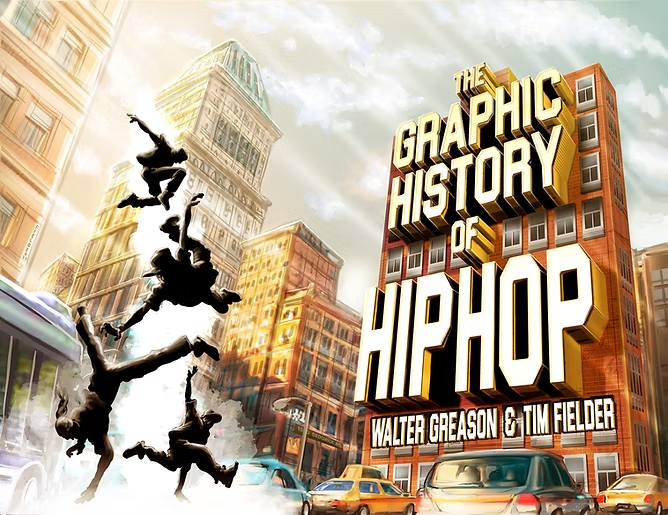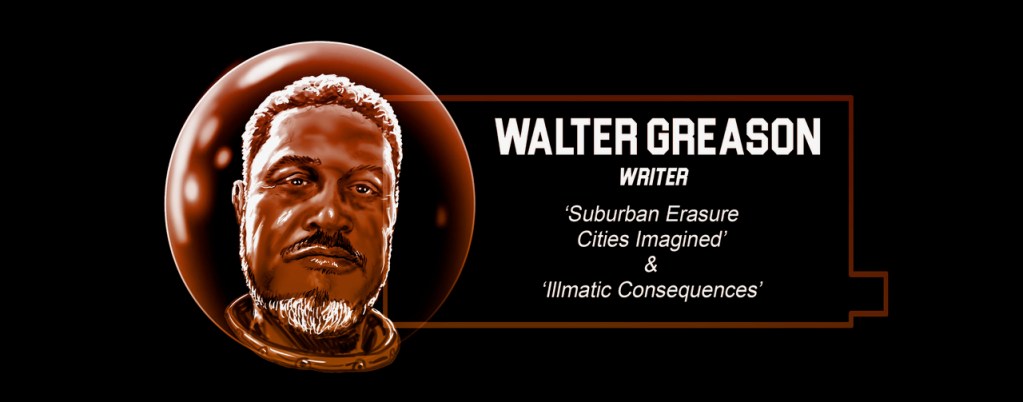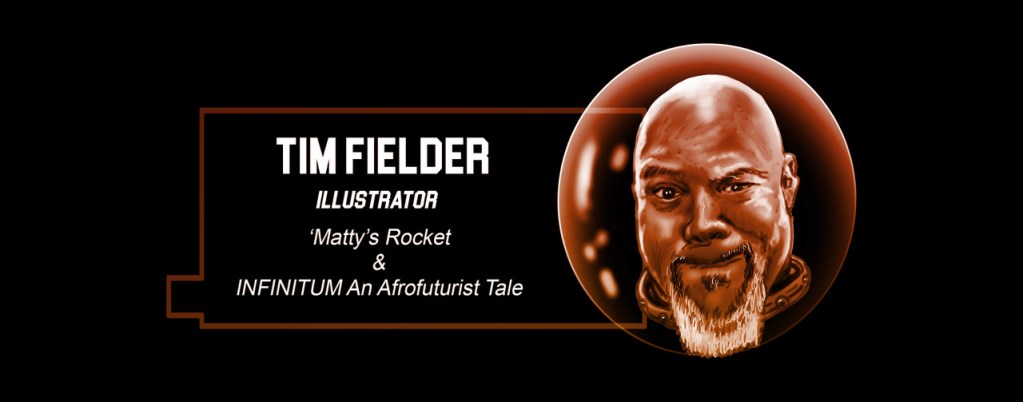Are you an academic open to making an impact with your research in creative ways? Dr. Walter Greason is back on The Social Academic podcast with artist, Tim Fielder. They created The Graphic History of Hip Hop, a graphic novel taking the education sector by storm. When I asked, “did you expect this kind of response from your book?” It was a definite no. The ripple effect of engagement and impact The Graphic History of Hip Hop is creating for students is inspiring.
Hi, I’m Jennifer van Alstyne. The Social Academic podcast shares interviews with academics and people in Higher Education. When The Graphic History of Hip Hop was announced, Walter and Tim got billions of views that has helped their book and style of sharing history reach people around the world. I’m excited to share this featured interview with you.
Before we get started, this Saturday, April 12, 2025 is my Promoting Your Book Online for Academics workshop. I’d love for you to join us. It’s at 11:30 am Pacific Time / 2:30pm Eastern Time, and there will be a replay if you can’t make it live. Get info about the workshop and register.
In this interview

Meet Walter Greason and Tim Fielder


Jennifer van Alstyne: Hi everyone, I’m Jennifer van Alstyne and welcome to The Social Academic. Dr. Walter Greason is back for another interview and he brought his collaboration partner for The Graphic History of Hip Hop, Tim Fielder. I’m so happy you’re both here. Tim, would you introduce yourself for people?
Tim Fielder: Hello, I am Tim Fielder. I’m a visual Afrofuturist and graphic novelist who has had the pleasure to work with the endowed chair at Macalester College, Dr. Walter Greason.
Dr. Walter Greason: You’re hilarious, man.
Tim: We’re going to ride him like that. We’re going to ride him. He just got it about a month ago and every time, you used to be Dr. Walter, now he’s the endowed chair Dr. Walter Greason.
Jennifer: Oooh! [Laughing]
Tim: So we’ll see. So we’ve been riding him. He earned it though. I’m so proud of him. It makes me look good to work with Walter because Walter is so accomplished in what he does, not just being a hip hop scholar, generally a nice guy, a unashamedly justice, social justice warrior, and he keeps me, he’s an all-star, north star. And he makes all of us around him work harder. He makes us want to aspire to work harder. And by just the association alone, having done The Graphic History of Hip Hop has made me a better artist and has brought me, you know you think, “Oh, this would just be a freelance job.” Nah. Having done this book with Walter has exposed me to opportunities that I could not have dreamed up. So it has been a true, true ride.
Walter: I appreciate you.
Tim: He’s still crazy though, don’t get it mixed and twisted.
Walter: I appreciate you, you know, really. Anything I bring is a reflection of the people that I work with. And y’all are two of the folks that make me so inspired every single day. For Tim, the way his genius manifests in the production of the work. And I’ve seen it now firsthand, in person. God, its got to be like six years since we first did that thing with N Square. But man, like his ability to touch people’s soul and to move them, to find something extraordinary in themselves that they couldn’t see before he drew them. That, that is just a miracle every single time it happens.
And Jennifer, the work that you’ve done that I’ve seen you put together since our time back in New Jersey. You are doing that with these shows, with this effort to motivate people.
And I want to specifically congratulate you for the amazing series you’ve done recently with Sheena Howard. That’s another colleague of mine going back many years. And so just, this is like family for me to be with y’all. And I couldn’t do the kinds of things I try to do without y’all being out here in the world and showing me different ways to go about making things happen.
Collaboration of academic research and art
Jennifer: That really brings up this amazing collaboration that you did together. I’m curious, it sounds like you worked on something six years ago. What inspired your collaboration and decision to actually work together to create something different, to create something unique?
Tim: Go ahead Walter, you can start. I’ll hold the prop up.
Walter: So Graphic History of Hip Hop, we got invited to put that together by the New York City Public Schools in December of 2022. But prior to that, so Tim and I met in, um, it was Jackson, Mississippi at the Planet Deep South Afrofuturist Conference. Which was just a convocation of talent that has changed the world in, in very literal terms.
This was years before the Black Panther movie debuted. This was long before most people around the world knew what Afrofuturism was. So this was an event that was life-changing for everyone there just to be together, but Tim took the photo that symbolizes the event. And so many, many decades from now, when we are no longer here and people are telling the story of Afrofuturism, it’s going to be Tim’s. Not just his images, but his photography that actually tells the story of how the movement has grown and how it had this impact. That photo still lives in all of our hearts cause his skills with the selfie are unmatched. That was one of the moments where I was like, “This dude has got it. Whatever he’s got, I need to stay in touch and be a part of it.” A couple of years later I want to say 2020, 2021, we got invited by Reynaldo Anderson. No, 2022.
Tim: Oh yeah, I’m sorry. That was Yonkers.
Walter: Then we were trained in technically how to be futurists by a consulting group that works with the Air Force. They were working on how to imagine a world without nuclear weapons.
That’s what convinced me that I had to work with Tim. I’m there talking about all this policy and structural reform. How do we actually build a safer world for the future? And he instantly created visualizations of the things we were talking about. I was like, “Dear God, like that’s, that’s the most amazing thing I’ve ever seen.”
I made a note that the next opportunity I had to ask him to do something I would. Sure enough, December 2022 managed to catch him around Christmas time. He was like, “Oh, this dude, I don’t know. We’ll see.”
He came on board and was like, “All right, I’ll take a shot. I’ll take a shot.” And man, it has just been warp speed, Star Trek ever since just every day. Some amazing new thing happens for us. This has been spectacular. I’m sorry, Tim. You tell the story better than I do.
Tim: No, no, no. He’s right. It’s just, that’s the thing. I’m not the fastest artist out there. You know, I can do fully rendered work. I use advanced technology. I use everything available to me on my work. But unlike other projects I’ve worked on, this project doesn’t seem to want to die.
We did South by Southwest (SXSW). Was there and I thought, ‘Okay, we’re done. That’s it. It’ll slow down.’ Then, you know, we did the Spin Magazine, they featured us in their December physical issue. Told us, “Well, you guys won’t be in the online version, just in the print version.” Then without announcement, bloop, it just pops up in the online version. That’s what it’s been. It’s been that kind of thing that seems to be an experience in perpetual momentum.
Tim: And it’s been that kind of experience. I know so much more about hip hop that I did when I started. I’m not Walter. I’m not a scholar like that, but I have been forced to learn about the form and it has made me a better artist as a result. A dramatically better artist.
We’ll see what happens, you know. But in 2022, he called me and we put it together. First, it was like a floppy. We thought it was a 100,000 copies of this floppy distributed into the New York City School System. Then we were told it was a 150,000 copies. But we learned two weeks ago that it was 200,000 copies. Is that correct, Walter?
Walter: Yeah, that’s what Joe’s been talking about.
Tim: 200,000 copies, which is kind of frightening. But you know, hey, what you going to do, say, “Don’t put 200,000 copies of that book in those schools.” You know? So it’s in there and then we’re working on Volume 2 now.
Our partner, Christina Hungspruke LaMattina partnered with us and we decided to do this here, which is the full-on graphic novel version. So that 24 page version became a 92 page graphic novel, which of course was done, it wasn’t planned like that. I always use this joke, it will be good.
Never request a timeline from a historian
Tim: Never request a timeline from a historian. Don’t do that. It’s like, really, I didn’t know what that meant when someone told you, “Well, you, what do you mean? Don’t give them a timeline. Don’t ask them for a timeline.” They should know. No, it has nothing to do with what they know. They will go above and beyond.
The book was out, there was a lot of media. People would download it. We were on TV and everything, traveling around. We did this New York tour. It was insane. And Christina is like, “We got to do something else because they’re giving the book away,” because it was free. The DOE (Department of Education) version was free. Right? So you can download it right now.
But we wanted to start a company. So we started a company miraculously named The Graphic History Company. Seems so self-explanatory. So we did that. Yes, we did that.
I asked Walter, “Hey man, I need you to give me a timeline because I’m going to put it on the website. And I’m thinking, ‘he’ll do it by decades, you know: the 70s, 90s. It would just be a few paragraphs and I could do it.
This guy comes back a day later with 45 years worth. And I’m like, oh my God. Cause I mean, I just remember saying, “There’s no way I’m putting this on the website. This is the graphic novel. This is the expanded version.” And of course we added dates, moved stuff around. I think it starts in 1964 and it goes all the way to 2006. This is just Volume 1. We could not finish the entire history of hip hop in one volume. We’re doing 3 and it still won’t be done. But it’s as far as we going to take it.
But yeah, it changed my life. I thought when I did it, this is going to be a basic freelance job. It has utterly failed in that department. A career defining moment for me, for sure.
Subscribe to The Social Academic blog.
The form above subscribes you to new posts published on The Social Academic blog.
Want emails from Jennifer about building your online presence? Subscribe to her email list.
Looking for the podcast? Subscribe on Spotify.
Prefer to watch videos? Subscribe on YouTube.
Book adoptions from every major city school district in the country
Walter: Yeah. We knew we had to do something big. We knew we had to do something bigger.
We knew we had to do something big because when we went to Queens and the middle schoolers stormed over the tables. They grabbed us and pulled us to the floor, demanding that we sign copies. We give them more copies. Like it was, Tim was very wise to get a hold of video from the teachers who witnessed the mass assault. It’s just been this thing where we go to DC, we go to Virginia, we go down to Louisiana. Tim was just at South by Southwest in Texas.
Everywhere we go, the energy around this book is so enormous. And that’s the thing. It’s not just in the New York City schools. We’re getting adoptions from every major city school district in the country. I was just talking with somebody in London who’s talking about adoptions over there. It’s far larger than anything we anticipated when we first started trying to put it all together.
VIDEO: Watch New York schools substituting traditional history textbooks with comics on CBS Chicago.
Jennifer: What is an adoption?
Walter: It’s when either a school or a district looks at their student body, looks at their curriculum and says, “Oh, we need this to be part of what we teach.” And so the hundreds of thousands of copies in New York City, they’re just there on demand for everybody in the city.
Then we have folks in Richmond who have written an extraordinary lesson plan that have made it not just available for Virginia, but they’ve made it easy for teachers to teach it everywhere. And so the teachers start clamoring for it because frankly, the educational effect is unparalleled.
Students that are grade levels behind in reading all of a sudden become intensely excited readers and they catch up to grade level. The kids that are at grade level, they start jumping years ahead because they can’t stop reading.
It’s not just literally the history of hip hop. It’s the combination of the art, the music that we discuss, and then underneath all of it is the history that then they learn, they internalize, they memorize cause they literally just can’t stop reading it. It goes on to everything else that they’re trying to learn. It gives them a love of learning and reading that they didn’t have as intensely before.
Art and graphic novels by Tim Fielder
Jennifer: What about working with Tim, what about making this visual makes it more effective not just for young students who are sounds like knocking you down because they’re so excited. Like that’s amazing. But as an adult reading this book, this was fascinating for me to learn about this history and to experience it in a visual way. So I’m curious, what about that partnership was most creative? Or, what lit your spark together?
Walter: So Tim has done a couple books. Yeah. She asked me what the joy of working with you is given your amazing skills. So I’m definitely going to jump on that.
When it comes to Tim’s work and looking at either Matty’s Rocket or Infinitum, which are his books that he did, was really well known before he ever started talking with me for real.
You see in his art, this kind of vibrancy of each individual. But I love in Infinitum, the way that he took his vision of an undying main character and he turns that into this, this experience where you’re looking through the man’s eyes and you’re feeling the kind of arrogance initially. You’re feeling like the embodied intellect, the suffering that comes to be inflicted on the character. It is so visceral that when Tim is crafting work, this is what I was saying about doing portraiture of individuals, is they see things about themselves that they never saw before.
That’s this amazing gift that comes through the production of graphic art. And particularly his skill is that it taps into something that is unique to all of us and often something that we don’t appreciate until we see it reflected back. So now that that’s been for me as a historian, as a scholar who writes about forgotten people in places, to see them just recognized and just presented in a way that other people can encounter them and understand them is astonishing on its own. But then when the people themselves see the way that they’re represented and the way that the joy pours out of them. That they become so excited about what they want to say and how they want to add more to what we’ve done. There’s no better gift. Tim talks often when we go around these places about the way people respond with good will and are just thrilled to connect with us.
As much as I love doing history and can do history well in various contexts, that’s primarily his art. His art is what makes the connection that then inspires the joy and the excitement. And so I’m going to give all the credit because you know, Tim is very, very kind and then, will shy away. But he knows my stuff is full of really deep and hard things to grapple with. People can get overwhelmed by it. He is extraordinarily good about keeping the joy of the process at the center. And that’s what really makes folks most excited to do these things with us.
Making an impact in education with The Graphic History of Hip Hop
Tim: Thank you for that. I appreciate that, brother. However, now let me interject. So the very nature of a graphic history, it’s not a graphic, it’s not a history that’s told just with prose. It’s about the marriage and the dance between the written word and the picture. Right? So it really is a form that is totally unique. It’s a comic book, right? But graphic novels are longer-form comic books. And it really is a longer form where you’re telling a self-contained story as best you can where you’re trying to convey the same level and depth of written narrative by coupling it with the visual narrative.
That’s not an easy thing to do because obviously the academic thing is that, you know, you do a book, 200 people read it and that’s considered a norm. The idea of doing this book, at least for me, was about taking that very learned academic style,(…) right? Which the floppy was initially done for 11th graders.
And then the challenge when we expanded it actually broadened, as far as I’m concerned, broaden it so that it can expand to different ages and people who were much older because we began to deal with more and more and more obscure stuff in the story. So you had your Arsenio Hall, which was, oh, everybody knew Arsenio Hall. But then you have that thing where certain acts I had never heard of. But doing within a context. I forget, who was the one…What’s the one with the World Trade Center?
Walter: That’s not a group. That’s Immortal Technique. That’s Immortal Technique, a basically New York City rapper at the turn of the century and still does amazing work today.
Tim: Exactly. But the way we did that image, we had to juxtapose with the World Trade Center accident because hip hop is not some separate part of culture. It’s a part of the world of black culture. American culture. Latino culture. It’s world culture.
And so the challenge for me was taking this very real kind of real dense, almost Tom Clancy level geopolitical perspective and seeing how he intermixed it with hip hop history. My job was how do I make this stuff look good and be informational? So it’s not just dealing with it. It’s like, yes, you want the images to look good, but you also want them to serve as an infographic if you will.
That kind of blend of those things and I have to say, has absolutely made me a better artist. I know I keep repeating that. But I think it’s made the field of graphic history move for me. There are other books out there. March, you know, just goes on and on out there, Maus that are great. But I’m very proud of this book because it’s moved this form, right? Which in this time of day, you got book bans and all like things like that.
Our book has been able to somewhat survive because doesn’t even really matter your political background. Everybody listens to hip hop. It literally cuts across the board and to be involved with such a project that succeeds on an artistic level, but then it begins to potentially and progressively affect public policy.
That’s when you really getting in the grease because then it’s not just a vanity project based on entertainment. You’re influencing the way people run their school systems, the way they’re running their interactions with their educators. There’s a reason why we just were the keynote at the Minnesota Council for Social Studies thing. And it’s because beyond the fact that, you know, we’re nice guys. We’re always going to have fun. We’re going to bring the joy, bring the fun.
There’s still this context that the teachers can not only get the information, but they get information from how we present that they can take back to the classroom. And I think that, that’s what allows what Walter and I do together. I’ve done some talks before, not a lot. But the last year and a half, we’ve done a lot of these things and we’ve refined at such a point now that now we’re probably going to start bringing music, some form of that into the presentation. That’s literally where we’re at. I’m sorry, that was a droning on answer to your question.
Jennifer: I loved it, especially because what you each gained from this collaboration by working with each other was a spark that really rippled. It had like ripple effects for education systems, for students, for other educators that are seeing themselves in what you’ve done in the sense that like, “Oh, maybe I could do something like that too. Maybe I could create something that’s a little different. That’s not maybe the traditional academic monograph, but still has the potential to influence public policy and practice.”
Tim: It’s in comics or the sequential art medium has the ability to connect with people. It allows people to move into the process of reading much more easily. And this is not just for kids, it’s for adults too.
But I believe particularly due to the travels that Walter and I are engaging, and like I said there have been other graphic novels before that. But because we pretty aggressively…I would have maybe tried to like, well not really. Nah, we pretty aggressively engaged the education sector. I mean, very aggressively in terms of both the local school systems, but then on the college level. So we’re doing all of it at the same time. I know, so much more. Like I didn’t even know there was a convention system for social studies. I didn’t know that. I thought, “Well, it was just-.” But like no, they have their whole convention scene too.
I believe that we are now starting to influence other academics to take the job because they’re using what we do as a model.
Jennifer: Yes.
Tim: It’s not like some stand off thing where you have some larger than life figure. It’s just regular dudes, you know, who are out there. I mean, well, the endowed chair will never be regular. But you get my point though. We’re regular guys who are doing our work and other academics are seeing that “we can do that too.” So it’s all for them. The field of what could be told is unending.
Subscribe to The Social Academic blog.
The form above subscribes you to new posts published on The Social Academic blog.
Want emails from Jennifer about building your online presence? Subscribe to her email list.
Looking for the podcast? Subscribe on Spotify.
Prefer to watch videos? Subscribe on YouTube.
Graphic novel vs. academic monograph
Jennifer: What felt different about creating this book and seeing it out there, seeing it in the hands of students as opposed to your academic monographs. And I’m not saying like some books are better than others, but I’m curious how it felt in terms of that actual interaction with the readers?
Walter: Oh, it’s amazing. So you know me from my work in education and that’s different for me than it is for some other professional historians is that they go in to primarily do their research and to write their books. And teaching is secondary if not third place among their priorities. For me, the teaching is first. That’s always been it. I was teaching in P-12 systems for 17 years before I became a higher ed academic.
Jennifer: I didn’t know that.
Walter: Yeah, this is now 20 years. No, more than that. 27 years since I taught my first college class. And so this has just been a journey for me that is rooted in education. And so the connection with students, connection with families is my top priority. It’s the reason why I teach at Macalester College in St. Cloud, it’s an institution that shares those values and is committed to the education first.
And then everything else, just like in my life, flows from that foundation, that basically I teach so that I can do more research, so that I can do more service in communities around the world. And that’s the way my life is built. To then come up and find a tool like the graphic, like graphic history generally no matter what subject it covers.
But specifically The Graphic History of Hip Hop that shows the commitment that shaped who I am. I would never be who I am without hip hop. And then from there to then grow that out and have that effect spread to people in every part of the world. When we first launched this almost a year ago, we had billions of engagements. Like 3-4 billion engagements from people online looking for, “What is this? What is this content? How can we get a hold of this? How can we use it?”
That’s why we have connects in Germany, and Japan, and New Zealand, and all these other places that are pulling on what we do. This morning, some folks from Senegal were in my ear about “we need this as part of our national education curriculum.” They speak French, they want French copies. So we got to figure out, how do we reword everything in French?
It’s just amazing to me because that’s the highest priority, is that we got to do things that other educators never even attempt to. The other professors that I work with who have had the kind of success that I’ve had in college, they typically say to me routinely, “I only write for 2 other people. You know, there’s me and there’s 2 other experts that that’s who I care what they see. And then how do they understand what I’ve written?”
A big group here in St. Paul has, someone approached me yesterday and was like, “there are like 20 people who can really understand the quality of the work that I do.” And that’s pretty much the academic standard, is that you have a small group of people that you share kind of a community of knowledge.
But this is very different. My community of knowledge grew most rapidly through social media, kind of leading up to the Black Panther release and Afrofuturism. A lot of the work I did on racial violence, these things gained really global audiences. But the practice and the application of this knowledge through The Graphic History of Hip Hop is unprecedented. And so the people read it, they feel it, it moves them emotionally. None of the other books I’ve done have that same kind of impact.
Tim: I have to say that Christine and I, our other partner. First of all, you have to understand for him to say what he said. It took a long time for us to get into that point. I am so proud of him because he’s now, you know, hey, dyed in the wool academic. There’s a certain standard. You have to get your citations right. And all the big wig technical words that I don’t know what they mean. This guy was that. He is that guy.
What I am so proud of him with doing is he has found a way to maintain his integrity with that and blend it with this mass form. And I think frankly, what’s beyond the obvious that many, many, many more people are reading his stuff than almost any academic on the planet with the exception of a handful.
The thing that makes what he’s doing so important is that it’s actively affecting social change in the schools. Think about it. How many people can actually write a book where they can cite that school systems are adopting the book on multiple levels, right? We’re asked to talk about it all over the country, right? There are other countries asking us to utilize this modality. How many people, academic or no, get to have that level of effect?
Subscribe to The Social Academic blog.
The form above subscribes you to new posts published on The Social Academic blog.
Want emails from Jennifer about building your online presence? Subscribe to her email list.
Looking for the podcast? Subscribe on Spotify.
Prefer to watch videos? Subscribe on YouTube.
It took over my life, and I’m so glad it did
Jennifer: Did you expect that kind of response when you started this project or was it more of a surprise? Either of you? No, Walter’s face is like, no!
Tim: Hell no. Hell no. I expected, I’m going to be honest with you. Like I said, initially I thought, “this will be a great freelance job. The money is good.” I’ll do it and I’ll be known as that. And that’ll be it. And it won’t take over my life.
It actually took over my life. It took over my other projects, which have not made my other editors very happy, but it really did. And I’m so glad it did because again, it’s made me a better artist.
There are different sectors of the publishing world when it deals with comics. You have the direct sales market, which is Superman, Batman, Spider-Man, but that industry is actually imploding now as we speak. It’s because the primary distributor has gone under and started to sell off the assets. So local comic book shops no longer, it’s difficult for them to get access to content. And you know how the marketplace works. The more difficult you make it for your potential customers to get access to your content, you know, that feeds itself.
But then there are these other aspects. There is the academic market. There’s the graphic novel market, which we’re in. But we braced academic and the graphic novel market. And then there’s manga. So we do graphic novels and academic. Right? So what we’ve done is allowed us to have this ability to be able to effectively surf. And I use that word, both worlds, both waves, if you will. And it, but I couldn’t have told them, “Look guys, we should publish through Ingram.” And that was the best I could do.
But after a while, it is now taking a life of its own to where The Graphic History Company is a multimedia company. It really is. It’s a multimedia company and it’s allowed me as an operator. I have interest in marketing and promotion because I talk a lot, as you can see. But what it’s done is allowed me to be able to practice muscles I never thought I would have been able to practice. Due to this book has gotten me in the Washington DC SET. I never thought that would happen, but it did. You know, it did. It’s allowed us to be approached. We’ve been in the Smithsonian. We’ve been in the Metropolitan Museum of Art. And I’m listening up and thinking, yeah, that’s right. We did that. And it’s all because of this book.
Buy the book

Jennifer: If you are watching this, it’s time to get your copy of The Graphic History of Hip Hop. And it sounds like, is the graphic novel version also like, can I buy that?
Tim: Yes.
Jennifer: Okay. I’m going to go out and get my copy of the graphic, graphic novel version too because I want to see all of the things that didn’t fit into this one. I’m really excited to see your art, Tim and Walter, to see this breadth of history that I knew nothing about to really dive into it. It’s exciting for me. And for everyone who’s watching, if you’re someone who has an idea or a dream about a book project and maybe it’s not going to look the way that your traditional academic edited collection or monograph is going to look, it sounds like this could be a real opportunity to create the change you want to see in the world. For Walter and Tim, it really sounds like it went beyond your expectations.
Walter: It’s amazing. And I do think you have the graphic novel one. Yours I think is 90 pages. Looks like the hardcover. I’d be amazed if you had the floppy because that didn’t, not many got out of New York.
Jennifer: Oh yeah, no, this is 89 [pages]. Yeah. I want the hardcover version. That’s what I’m asking about. Yeah.
Tim: So you got hardcover and softcover version, 92 pages. And you know, the hardcover can be used as a weapon in a pinch. So really something there for everyone.
Jennifer: Amazing. Is there anything else you’d like to add before we wrap up? I want to give you time for anything else you’d like to share.
Walter: Just that I love the work you do, Jennifer. And anytime we can do anything to support the work, and especially the way that you have served the academic sector has been spectacular.
I want to encourage all of my colleagues, everyone who is doing this work out here to come and visit with you because it is absolutely essential for us to build all the different kinds of careers we have based on the knowledge that we’ve acquired.
Jennifer: Thank you!
Tim, anything you’d like to share?
Tim: Yeah, presently working on Volume 2, which I hope to have some day before my hair grows back. And we’ll have that out and out to the public. And then got to work to Volume 3and hopefully some news, please Lord, I’ll be hearing very soon. I’ve been bothering Walter about why haven’t we heard anything. So if that happens the way I want, it’ll be really interesting, but I’m not going to jinx it.
Jennifer: Fingers crossed.
I wish you both all the best with your collaborations and your own initiatives in the future. This has been such an interesting conversation for me. I can’t wait to share it with people.
I hope they all go out and get The Graphic History of Hip Hop because this is, wow. I mean, it’s just so colorful and engaging and memorable. I think that even if you’re not someone who identifies as a graphic novel reader, maybe you don’t read comics that are in other things, this can still really be engaging. And it was surprising for me to see how into it I got knowing very little about hip hop. Thank you so much for coming on The Social Academic.
Tim: Thank you.
Walter: Much love. Thank you.
Subscribe to The Social Academic blog.
The form above subscribes you to new posts published on The Social Academic blog.
Want emails from Jennifer about building your online presence? Subscribe to her email list.
Looking for the podcast? Subscribe on Spotify.
Prefer to watch videos? Subscribe on YouTube.
Congratulations to Illmatic Consequences
Illmatic Consequences: The Clapback to Opponents of Critical Race Theory—edited by Dr. Walter Greason and Danian Darrell Jerry has been honored with the 2025 Anna Julia Cooper and C. L. R. James Prize for Outstanding Research in Africana Studies at the National Council for Black Studies (NCBS) Conference.
Bios
Walter Greason

Dr. Walter Greason, Ph.D., DeWitt Wallace Professor in the Department of History at Macalester College is the preeminent historian of Afrofuturism, the Black Speculative Arts, and digital economies in the world today. Named one of “Today’s Black History Makers” by The Philadelphia Daily News, Dr. Greason has written more than one hundred academic articles and essays. His work has appeared on Huffington Post, National Public Radio, and The Atlantic among other popular, professional and scholarly journals. He is also the author, editor, and contributor to eighteen books, including Suburban Erasure, The Land Speaks, Cities Imagined, Illmatic Consequences, and The Black Reparations Project.
From 2007 – 2012, Dr. Greason was an advisor to Building One America, the coalition that designed the American Recovery and Reinvestment Act (2009). He also served as the Founding President of the T. Thomas Fortune Foundation, an organization that saved the National Historic Landmark dedicated to the leading, militant journalist of the nineteenth century. Dr. Greason’s digital humanities projects, “The Wakanda Syllabus” and “The Racial Violence Syllabus”, produced global responses in the last six years. His work in historic preservation and virtual reality continues to inspire new research around the world. Dr. Greason currently writes about the racial wealth gap and the patterns of economic globalization.
Dr. Greason is currently serving as a special consultant to the Institute for the Study of Global Racial Justice at Rutgers University in New Brunswick, New Jersey.
@WalterDGreason
Tim Fielder

Tim Fielder is an Illustrator, concept designer, cartoonist, and animator born in Tupelo, Mississippi, and raised in Clarksdale, Mississippi. He has a lifelong love of Visual Afrofuturism, Pulp entertainment, and action films. He holds other Afrofuturists such as Samuel R. Delany, Octavia Butler, Pedro Bell, and Overton Loyd as major influences. He is the creator of the graphic novels INFINITUM: An Afrofuturist Tale, published by HarperCollins Amistad in 2021, and the Glyph Award-winning ‘Matty’s Rocket.’ Fielder is also known for participating in the Carnegie Hall Afrofuturism Festival exhibit ‘Black Metropolis’ and The Smithsonian National Museum of African-American History and Culture exhibit ‘AFROFUTURISM: A History of Black Futures’.

